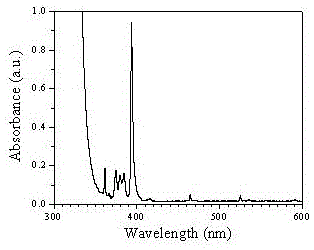Method for preparing Eu3+ labelled molecule imprinted sensor used for pesticide residue detection
A technology of labeling molecules and molecular imprinting, which is applied in the field of materials science, can solve the problems of slow binding kinetics, small number of recognition sites, and no signal output, etc., and achieve highly sensitive trace detection, high selectivity and trace detection Effect
- Summary
- Abstract
- Description
- Claims
- Application Information
AI Technical Summary
Problems solved by technology
Method used
Image
Examples
specific Embodiment approach
[0054] detailed description: A kind of Eu for the detection of pesticide residues 3+ Preparation method of labeled molecularly imprinted sensor, including Eu 3+ Pre-assembled with 3-aminopropyltriethoxysilane (3-aminopropyltriethoxysilane, APTS) and the pesticide target analyte chlorpyrifos molecule, after hydrolysis and condensation to obtain Eu 3+ The labeled chlorpyrifos molecularly imprinted silica nanoparticle sensor is characterized in that: the Eu 3+ After the template molecule (the target analyte chlorpyrifos molecule) is eluted from the labeled chlorpyrifos molecularly imprinted silica nanoparticle sensor, it has a selective recognition site for the target analyte chlorpyrifos molecule, and the target analyte chlorpyrifos molecule enters the silica After the recognition site of the nanoparticle sensor, it will be further combined with the Eu on the recognition site 3+ The ions are chelated, based on the principle of rare earth chelation luminescence, the target an...
Embodiment 1
[0058] Example 1: According to the principle of rare earth chelation luminescence, using Eu 3+ Chelate with the target molecule and the amino group in APTS, and obtain Eu 3+ labeled molecularly imprinted SiO 2 Nanoparticle sensor. Specific steps are as follows:
[0059] Weigh 0.0312g of Eu 2 o 3 Place in a 25mL beaker, add 250μL of concentrated nitric acid and 1300uL of deionized water to it, and sonicate for 7min, and when the solution is clarified, Eu(NO 3 ) 3 solution. Take 0.0368g of chlorpyrifos and ultrasonically dissolve it in ethanol solution, then add 240 μL of APTS to the solution, then add this solution to the previously prepared Eu(NO 3 ) 3 solution, and then put the solution in a 250mL round bottom flask, ultrasonic 9min, after standing still for 28min, add 2.9mL TEOS, adjust the pH to 10 with ammonia water, add 90mL ethanol water to adjust the volume of the solution to 100mL. The solution was placed on a magnetic stirrer, stirred at 750rpm for 3min, and ...
Embodiment 2
[0060] Embodiment 2: Eu by weighing 0.0180g 2 o 3 Place in a 25mL beaker, add 240μL of concentrated nitric acid and 1300uL of deionized water to it, and ultrasonicate for 6 minutes. After the solution is clarified, Eu(NO 3 ) 3 solution. Take 0.0240 g of imidacloprid and ultrasonically dissolve it in an ethanol solution, then add 220 μL of APTS to the solution, and then add this solution to the Eu(NO 3 ) 3 solution, and then put the solution in a 250mL round bottom flask, ultrasonic 9min, after standing for 30min, add 2.5mL of TEOS, adjust the pH to 10 with ammonia water, add 85mL of ethanol water to adjust the volume of the solution to 100mL, put the solution in On a magnetic stirrer, stir at 750rpm for 5min, then gently stir (at a fixed speed of 500rpm) for 5h, the resulting solution is evenly distributed in three 50mL centrifuge tubes, and centrifuged to obtain the hydrolyzed imprinted polymer. Take 90mL of concentrated nitric acid, put it into a 500mL volumetric flask,...
PUM
 Login to View More
Login to View More Abstract
Description
Claims
Application Information
 Login to View More
Login to View More - Generate Ideas
- Intellectual Property
- Life Sciences
- Materials
- Tech Scout
- Unparalleled Data Quality
- Higher Quality Content
- 60% Fewer Hallucinations
Browse by: Latest US Patents, China's latest patents, Technical Efficacy Thesaurus, Application Domain, Technology Topic, Popular Technical Reports.
© 2025 PatSnap. All rights reserved.Legal|Privacy policy|Modern Slavery Act Transparency Statement|Sitemap|About US| Contact US: help@patsnap.com



